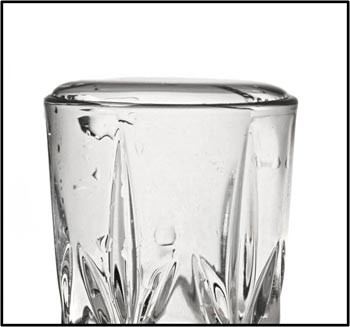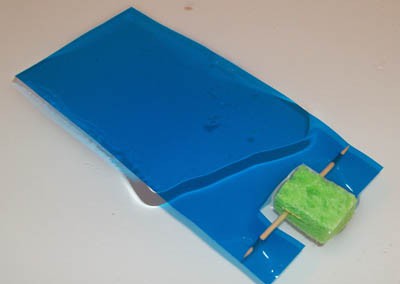Abstract
Have you ever wondered why a water strider can walk on water? Or how detergent can clean your dishes? If you observe carefully, you can find dozens of similarly interesting phenomena that are all linked to the surface tension of water. In this science project, you will investigate the properties of water surface tension.Summary
Editors: Andrew Olson, Justin Spahn, and Teisha Rowland, Ph.D., Science Buddies

Objective
Investigate how a small raft made from a clear plastic sheet can be propelled by water surface tension.Introduction
If you have ever blown up a balloon, you know it is pretty easy to blow up without becoming out of breath when it is made of soft, stretchy rubber. That is because the balloon offers little resistance to becoming stretched out as it is blown up. But for a balloon made of thicker or stiffer rubber, more energy is required to blow it up. The balloon offers more resistance to stretching. Think of a balloon as a model for surface tension. How "stretchy" the balloon material is determines how much resistance (surface tension) must be overcome by the energy of your blowing in order to inflate the balloon. Surface tension is defined as the energy required to increase the surface area by a unit amount.
Liquids also experience surface tension. The molecules (small individual particles) of the liquid experience intermolecular attractions, or cohesive forces, which simply means the molecules are pulling and pushing away from each other, just like magnets both attract and repel each other. In the case of a water molecule surrounded on all sides by other water molecules, every pulling force is balanced by a pushing force. The net (which means overall) effect is no change. But at the surface, where air and water meet, that is not true. The water molecules at the surface experience more pulls downward toward the other water molecules below them than upward toward the air. This is the surface tension of the water. You can see it at work when you fill a glass. Even if the water is at the rim of the glass, you can add just a few more drops so that the water is slightly taller than the rim. Do not believe it? Look at Figure 1 and then try it yourself!
 Image Credit: Sabine Dukes, Science Buddies / Science Buddies
Image Credit: Sabine Dukes, Science Buddies / Science Buddies
Figure 1. Because of surface tension, the top of this full glass of water curves outward. If more water is added, it will eventually spill over the side of the glass. Note the edge of the glass, and how far the water curves over it.
What can lower the surface tension of water? Water molecules like to interact with each other because they are polar molecules, meaning they have positively and negatively charged sides. Similarly to a group of magnets, the water molecules arrange themselves so that the positive sides are away from each other, but can interact with the negative sides. Other polar molecules also like to interact with water molecules. Molecules like this that interact with, and are dissolved by, water are called hydrophilic molecules. There are also molecules that do not like to interact with water. They are hydrophobic. What does this have to do with surface tension? If a molecule that has both hydrophilic and hydrophobic parts is added to water, the hydrophilic end will try to get close to the water molecules while the hydrophobic end will push away from the water. This pulling and pushing separates the water molecules from each other and decreases the surface tension because of this. Compounds that lower the surface tension of water are known as surfactants.
In this physics science project, you will make a small raft from a clear plastic sheet (a transparency), and see if you can propel it by taking advantage of the surface tension of water.
Terms and Concepts
- Resistance
- Surface tension
- Molecule
- Cohesive forces
- Polar molecules
- Hydrophilic
- Surfactants
Questions
- What causes the surface tension of water?
- How do surfactants decrease the surface tension of water?
- What do you think will happen to an object floating on the surface of water if the surface tension decreases?
- What happens to water molecules when a drop of surfactant is put in the middle of them?
Bibliography
These websites are good introductions to surface tension and surfactants:- Massachusetts Institute of Technology. (n.d.). Introduction to Surface Tension. Retrieved August 12, 2010.
- Exploratorium. (n.d.). Sticky Water. Retrieved August 12, 2010.
- Eco Nuts. (2011, December 14). Laundry Science 101: Surfactants. Retrieved August 31, 2012.
Materials and Equipment
- Kitchen sponges (2)
- Scissors
- Ruler, metric
- Transparencies, like those used on an overhead projector (2); available at your local office supply store
- Marker
- Toothpicks (1 box)
- Tape
- Large basin or sink
- It should be large enough that the raft can travel a short distance within it.
- Make sure it can be easily emptied, as you will be filling and re-filling it with fresh water often.
- Water
- Eye dropper; available at your local pharmacy
- Liquid laundry detergent
- Other substances to test their affect on water surface tension (try at least four):
- Liquid hand soap
- Toothpaste
- Vegetable oil
- Table salt
- Corn starch, vinegar, or any other substances you want to test
- Lab notebook
Experimental Procedure
Exploring the Existence of Surface Tension
- Cut the sponge into at least 10 small, identically sized pieces.
- We recommend cutting the sponge into pieces that are about 1.5 centimeters (cm) by 1.5 cm.
- The sponge will fit into a space cut in the back of the raft, as shown in Figure 2.
- Think of a shape for your raft and draw the shape onto the transparency. An example raft design is shown in Figure 2.
- The raft should be symmetric.
- The raft should be small enough that it can travel a short distance in your basin or sink, but still be large enough to hold the sponge piece.
- We suggest an initial size of 7-13 centimeters (cm) long, and a width that is approximately half of the length you choose.
- Record the size of your raft in your lab notebook.
- You will need to cut a space in the back of the raft where the sponge will be. It should be slightly larger than one of the sponge pieces.
- For example, if you made the sponge pieces 1.5 cm by 1.5 cm, you can cut the space out to be about 2 cm by 2 cm.

Figure 2. Example of a raft design. Note the way in which the small piece of sponge is attached to the transparency to prevent it from moving and sinking.
- Cut out the raft.
- Run a toothpick horizontally through one of the small sponge pieces so enough of the two ends of the toothpick can rest on the transparency, then attach the toothpick ends with tape so that the sponge is attached to the small space at the back of the raft, as shown in Figure 2.
- Fill a large basin or sink with tap water.
- Put the raft onto the water surface and let it float.
- Using an eye dropper, put a drop of liquid laundry detergent onto the sponge at the end of the raft.
- If one drop is not enough, put one or two more. The raft does not require much detergent to start moving.
- Observe the motion. Record all observations in your lab notebook.
- Empty the basin or sink. Also rinse the raft, especially the sponge piece, to get all of the detergent off of it.
- Note: The basin or sink needs to be emptied because the water will have too much detergent in it for its surface tension to change if more detergent is added.
- Repeat steps 5-9 with the same raft and sponge at least two more times. This will help you determine if what you originally observed is a fluke or a real trend.
- From your background research, you should know that detergents decrease the surface tension of water. How can this help to explain your results?
Exploring Other Substances as Surface-Tension "Motors" for Your Raft
- In your lab notebook, make a data table like Table 1 with the substances you will be testing. You will be recording your observations in the data table.
- Replace the sponge on the raft with a fresh sponge.
- Fill up the basin or sink with fresh water.
- Put the raft onto the water surface and let it float.
- Put a drop of liquid hand soap onto the sponge at the end of the raft.
- Tip: You could carefully pump one drop, or unscrew the pump lid and let one drop fall from the tube that is attached to the pump onto the sponge.
- Observe the motion and compare it to the first raft, which used detergent. Does the raft still move? Does it move faster or slower than the first raft? Record your observations in your data table.
| Substance Used | Did the Raft Move? Yes/No | Fastest Speed? Yes/No | Good or Bad Motor? How Did It Affect Water's Surface Tension? |
| Liquid laundry detergent (first raft) | |||
| Liquid hand soap | |||
| Toothpaste | |||
| Vegetable oil | |||
| Table salt | |||
| Etc. |
- Empty the basin or sink. Also rinse the raft, especially the sponge piece, to get all of the detergent off of it.
- Repeat steps 3-7 two more times.
- This way you will have three trials for each substance you test. This will ensure your results are accurate and repeatable. Record all results in your data table.
- Repeat steps 2-8 using a difference substance until you have tested all of the substances you want to (try at least four). You can try all sorts of substances: toothpaste, vegetable oil, table salt, corn starch, even vinegar! Try out anything that you think might move the raft.
- To avoid introducing extra variables, make sure that you use the same raft for every test.
- Make sure to replace the water with new water for every test and thoroughly rinse out the sponge.
- Between testing different substances, rinse out the eye dropper.
- Tip: If you want to test toothpaste, use a toothpick to put it on the sponge and make sure you arrange it so that the toothpaste contacts the surface of the water, such as by putting some toothpaste on the back side of the sponge.
- Tip: If you want to test table salt, put a small dash of it on the sponge piece. Then add about 5 drops of water to help the salt dissolve.
- Which substances worked as a "motor"? Which ones did not? Which substance was the best motor? Can you relate your findings back to surface tension?
- Finish filling in your data table.
Exploring the Effect of Shape on the Motion of Your Raft
- Now test different raft shapes. Design other raft shapes and draw the shapes onto the transparency.
- Try at least four different shapes.
- You might want to experiment with different sizes, or different basic shapes.
- For example, you could try testing a large square, a small square, a large circle, and a small circle.
- Cut out the rafts, leaving a space for a small piece of sponge at one end of the raft as you did before.
- For each raft, attach the sponge at the end of the raft as you did before.
- In your lab notebook, make a data table like Table 2. You will be recording the measurements of your rafts in this data table.
- In your data table, record the shape and size of the rafts you just made.
- Prepare fresh water in the basin or sink.
- Put one of the rafts onto the water surface and let it float.
- Put one drop of the substance that worked best in the previous section onto the sponge at the end of the raft.
- Observe the motion. Did the raft move? Record your observations in your data table.
| Raft Shape | Raft Size | Did the Raft Move? Yes/No | Fastest Speed? Yes/No | Why Did the Raft's Shape and Size Cause This Motion? |
| Large square | ||||
| Small square | ||||
| Large circle | ||||
| Small circle |
- Empty the basin or sink. Also rinse the raft, especially the sponge piece, to get all of the substance off of it.
- Repeat steps 5-9 two more times to make sure you are seeing a real trend rather than a fluke.
- Repeat steps 5-10 using the other rafts you designed in step 1 until you have tested all of them.
- Which shape and size rafts moved? Which raft was the fastest? Why do you think the raft's shape and size caused this motion? Can you relate your findings back to surface tension?
- Finish filling in your data table.
Ask an Expert
Variations
- If the weight of the raft increases, how does this affect how well it travels using surface tension? You can try this out by taping extra transparency layers on to the raft, one at a time.
- How does changing the temperature affect surface tension?
- Try making boats with other materials to see if surface tension is powerful enough to propel bigger objects.
- Try using oil instead of water for the science project to investigate the surface tension of oil.
- Is the sponge necessary? Try the science project again, except this time, simply place a transparency raft in water without a sponge in the back, and drop some detergent behind the raft. Does the raft move forward? Is this a more efficient means of propelling the raft, or a less efficient means?
- For another science project on surface tension that includes a more direct measurement of the forces involved, see: Measuring the Surface Tension of Water.
- For a science project on the chemistry of surface tension, see: Measuring Surface Tension of Water with a Penny.
Careers
If you like this project, you might enjoy exploring these related careers:








